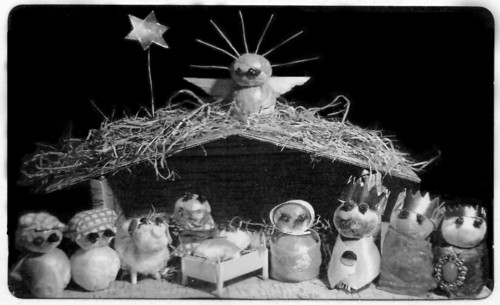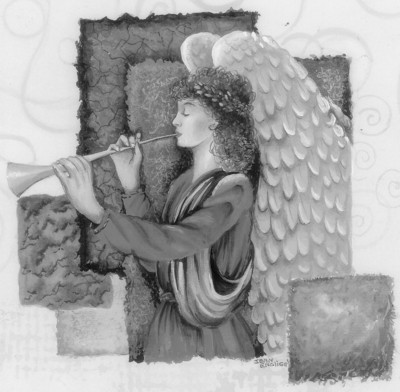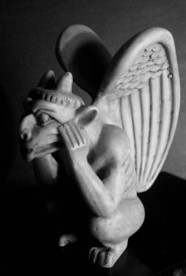Having been babbling so much about cribs lately, this seems an ideal moment to show you what I regard as the finest Christmas card I have ever received.
 Yes, it's the legendary Sprouty Nativity, as composed a few years ago by my Fairy Blogmother (rtd.) with her then beau, and which held pride of place atop my bookshelf until I was driven from Manchester just over a year ago.
Yes, it's the legendary Sprouty Nativity, as composed a few years ago by my Fairy Blogmother (rtd.) with her then beau, and which held pride of place atop my bookshelf until I was driven from Manchester just over a year ago.It's a gem, isn't it? I can't help but think how appropriate it is that my favourite Christmas card ever should have been given me by my most festively named friend, who this year delighted me with a gift wrapped so magnificently that I was loathe to open it. Never mind brown paper parcels wrapped up with string, in 2007 the cool kids are going for shiny black parcels wrapped in silver ribbons. It's all about black and silver.
But, like Peter David, I digress, so back to the card.
The Blogmother is the first to admit that Joseph does look a little like Kermit the Frog, and that one of the Magi doesn't really look all that interested, and it does appear to be the case that the shepherds are naked from the neck down in a decidedly unscriptural fashion, but for all that it's rather a classic tableau, isn't it? You've pretty much got all the classic elements of the story there, after all. Granted, the Archbishop of Canterbury might point out that having the Magi there alongside the shepherds smacks of conflation, but that's really only true if you assume that an image must represent just one instant in time, in which case you really must read Scott McCloud's brilliant Understanding Comics.
I know, I know, you might think that sprouts aren't quite the most appropriate substance from which the cast of a crib ought to be fashioned, but they're surely the vegetable most synonymous with Christmas, and is there anything that makes sprouts intrinsically less suitable to this than, say, stone, or wood, or papier mache?
Other than their tendency to decompose, I suppose, and the fact that some people really don't like them...
In terms of its content, the only really remarkable feature of this nativity scene -- other than the sprout figurines -- is the notable absence of the Ox and the Ass, so prominent in St Francis' celebration at Greccio in 1223 and in pretty much every crib you're likely see. Neither beast is mentioned in either of the Biblical Nativity narratives, and it seems their near ubiquity in nativity scenes derives from an allegorical reading of Isaiah 1.2 in the light of the Septuagint rendering of Habakkuk 3.2.
Or in other words, the first Christians believed, as memorably expressed by St Augustine of Hippo, that in 'In the Old Testament, the New is concealed; in the New, the old is revealed.' The Old Testament scriptures used by almost all the early Christians from the very beginning -- or at any rate from the point when they began to be referred to as Christians -- was the Septuagint, the Greek translation of the Hebrew scriptures. The Septuagint's inaccurate rendering of Habakkuk 3.2 -- 'In the midst of the years make it known' -- as 'In the midst of two animals make it known,' seems to have been read as a reference to Isaiah 1.3, which states:
'The ox knows its owner,Working on the assumption that everything in the Old Testament somehow related to Jesus, it's hardly surprising then that early Christians took both these passages as references to the birth of Christ. Besides, it's not really improbable that they'd have been present in the stable, considering that the manger must have had some purpose. Still, their presence in nativity scenes certainly shouldn't be regarded as obligatory, explaining Dr Williams' willingness to live without them.
And the ass its master's crib'
 While I think of it, and while on the subject of cards, I was perusing some of the parents' ones the other day. They're hanging from the wall in the living room, slotted into a banner that -- until it was properly unfolded the other day -- had rather cryptically wished us 'Merry Chris'.
While I think of it, and while on the subject of cards, I was perusing some of the parents' ones the other day. They're hanging from the wall in the living room, slotted into a banner that -- until it was properly unfolded the other day -- had rather cryptically wished us 'Merry Chris'.My favourite card in this particular banner is this one, showing an angel drinking a yard of ale. At least, I think that's what's happening. Something like that, anyway.
(No doubt someone will pipe up about he's holding a horn or blowing his own trumpet or some such. Balderdash, I say!)
Another one of the cards shows a Madonna and Child, in a classic pose such as that nabbed by me for most of my own cards this year, and bears the equally conventional legend, 'O Come, Let Us Adore Him'.
'Is that a suggestion to the shepherds or a request for permission from the mother?' I mused over dinner the other day.
'It's a Paxmanism,' replied Brother the Elder, retorting in those all too easily imatated tones, 'Oh come! Let us adore Him!'
Somehow, it's not quite the same, is it?
'Is that a suggestion to the shepherds or a request for permission from the mother?' I mused over dinner the other day.
'It's a Paxmanism,' replied Brother the Elder, retorting in those all too easily imatated tones, 'Oh come! Let us adore Him!'
Somehow, it's not quite the same, is it?

No comments:
Post a Comment